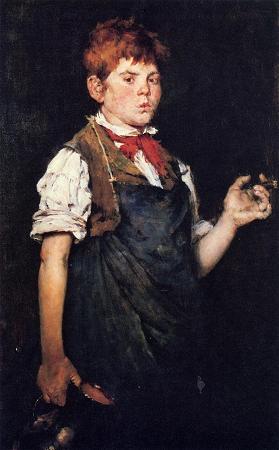William Merritt Chase (1849 - 1916). William Merritt Chase was an American painter, known as an exponent of Impressionism and as a teacher. He is also responsible for establishing the Chase School, which later would become Parsons School of Design. William Merritt Chase was born on November 1, 1849, in Williamsburg, Indiana, to the family of Sarah Swain and David H. Chase, a local businessman. Chase's father moved the family to Indianapolis in 1861, and employed his son as a salesman in the family business. Chase showed an early interest in art, and studied under local, self-taught artists Barton S. Hays and Jacob Cox. After a brief stint in the Navy, Chase's teachers urged him to travel to New York to further his artistic training. He arrived in New York in 1869, met and studied with Joseph Oriel Eaton for a short time, then enrolled in the National Academy of Design under Lemuel Wilmarth, a student of the famous French artist Jean-Léon Gérôme. In 1870, declining family fortunes forced Chase to leave New York for St. Louis, Missouri, where his family was then based. While he worked to help support his family he became active in the St. Louis art community, winning prizes for his paintings at a local exhibition. He also exhibited his first painting at the National Academy in 1871. Chase's talent elicited the interest of wealthy St. Louis collectors who arranged for him to visit Europe for two years, in exchange for paintings and Chase's help in securing European art for their collections. In Europe, Chase settled at the Academy of Fine Arts, Munich, a long-standing center of art training that was attracting increasing numbers of Americans and attracted Chase because it had fewer distractions than Paris. He studied under Alexander von Wagner and Karl von Piloty, and befriended American artists Walter Shirlaw, Frank Duveneck, and J Frank Currier. In Munich, Chase employed his rapidly burgeoning talent most often in figurative works that he painted in the loosely brushed style popular with his instructors. In January 1876 one of these figural works, a portrait titled Keying Up-The Court Jester was exhibited at the Boston Art Club; later that year it was exhibited and won a medal at the Philadelphia Centennial Exposition, and this success gained Chase his first fame. Chase traveled to Venice, Italy in 1877 with Duveneck and John Henry Twachtman before returning to the United States in the summer of 1878, a highly skilled artist representing the new wave of European-educated American talent. Home in America, he exhibited his painting Ready for the Ride with the newly formed Society of American Artists in 1878. He also opened a studio in New York in the Tenth Street Studio Building, home to many of the important painters of the day. He was a member of the Tilers, a group of artists and authors, among whom were some of his notable friends: Winslow Homer, Arthur Quartley and Augustus Saint Gaudens. In 1881, friend and artist William Preston Phelps travelled back to Europe to team up with Chase to go on a working tour of Italy, Venice, Capri then back to Germany. Chase cultivated multiple personae: sophisticated cosmopolitan, devoted family man, and esteemed teacher. Chase married Alice Gerson in 1887 and together they raised eight children during Chase's most energetic artistic period. His eldest daughters, Alice Dieudonnee Chase and Dorothy Bremond Chase, often modeled for their father. In New York City, however, Chase became known for his flamboyance, especially in his dress, his manners, and most of all in his studio. At Tenth Street, Chase had moved into Albert Bierstadt's old studio and had decorated it as an extension of his own art. Chase filled the studio with lavish furniture, decorative objects, stuffed birds, oriental carpets, and exotic musical instruments. The studio served as a focal point for the sophisticated and fashionable members of the New York City art world of the late 19th century. By 1895 the cost of maintaining the studio, in addition to his other residences, forced Chase to close it and auction the contents. In addition to his painting, Chase actively developed an interest in teaching. Initially he took on private pupils, among his first being Dora Wheeler, a student from 1879 to 1881 who became a professional artist and a lifelong friend. Dora's mother Candace Wheeler wrote in her memoirs of Chase's contagious enthusiasm, the most generous of teachers, not only giving exhaustively of his stored knowledge of how to do things, but fostering as well the will to do it. Later, somewhat against his will, he was persuaded to take charge of an art-school at Shinnecock Hills, Long Island.
more...














